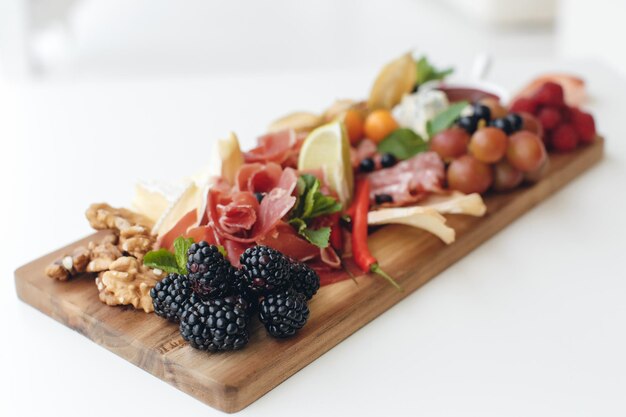Charcuterie boards have taken the culinary world by storm, offering a visually stunning and delicious way to enjoy a variety of flavors and textures. Whether you’re hosting a party, enjoying a family gathering, or simply treating yourself to a delightful snack, a well-assembled charcuterie board can elevate any occasion. The best part? It can be nutritious too! Here’s how to build a balanced and appealing spread that caters to both the eye and the palate.
Start with a Solid Foundation
The base of your charcuterie board sets the tone for everything else. Select a large wooden board, slate, or even a marble platter as your canvas. The size of your board will depend on the number of guests you’re serving. A larger board allows for more variety, while a smaller one is perfect for an intimate setting. Make sure your surface is clean and ready for a colorful array of treats!
Choose Your Proteins
When it comes to a charcuterie board, meats are usually the stars of the show. However, you can opt for a mix of traditional charcuterie, like prosciutto and salami, alongside plant-based proteins to cater to different dietary preferences. Here are some options to consider:
- Cured Meats: Look for high-quality options like soppressata or chorizo for their rich flavors.
- Plant-Based Proteins: Include options like marinated tofu or nut-based cheeses to make the board more inclusive.
- Fish: Smoked salmon or tuna can add a gourmet touch and boost your omega-3 intake.
Add a Variety of Cheeses
Cheese complements meats beautifully and adds creaminess to your board. Aim for a mix of textures and flavors, ranging from soft and creamy to hard and crumbly. Here are some cheese types to include:
- Soft Cheese: Brie or goat cheese provides a rich, tangy flavor.
- Hard Cheese: Aged cheddar or gouda offers sharpness and depth.
- Blue Cheese: For those who enjoy bold flavors, blue cheese can bring an interesting twist.
Consider slicing some cheeses and leaving others whole for a more inviting and interactive experience.
Incorporate Fresh Fruits and Vegetables
To balance the richness of the meats and cheeses, fresh fruits and vegetables add color and crunch to your charcuterie board. Here are some excellent choices:
- Fruits: Grapes, apple slices, figs, and berries can provide a sweet contrast to savory elements.
- Vegetables: Cherry tomatoes, cucumber slices, and bell pepper strips add a refreshing crunch.
Not only do they enhance the visual appeal, but they also contribute essential vitamins and fiber to your spread. Consider including nutrient-rich options like leafy greens or even taking a multivitamin like Cellsentials alongside your meal, a practice that supports your general health maintenance and well-being.
Don’t Forget the Carbs
Carbs can help soak up the flavors and complement the savory items on your board. Include a variety of options to cater to different tastes:
- Breads: Offer slices of baguette, crackers, or breadsticks for a crunchy element.
- Dips: Hummus, pesto, or a creamy spinach dip can serve as tasty accompaniments for your veggies and breads.
These additions make your charcuterie board more substantial and satisfying.
Sweeten the Deal with Nuts and Dried Fruits
Adding a handful of nuts and dried fruits can introduce delightful textures and flavors. Nuts provide healthy fats, while dried fruits offer a natural sweetness. Here are some options to consider:
- Nuts: Almonds, walnuts, or pistachios add crunch and nutrition.
- Dried Fruits: Apricots, cranberries, or raisins can serve as a sweet counterpoint to savory items.
These additions create a beautiful contrast and enhance the overall variety of your board.
Presentation is Key
Now that you have all your components, it’s time to assemble your charcuterie board. The goal is to create a visually appealing display that invites guests to dig in. Here are some tips for presentation:
- Group Similar Items: Cluster cheeses together, arrange meats in folds, and keep fruits and veggies in their sections.
- Use Small Bowls: If you have dips or spreads, use small bowls to contain them. This keeps the board tidy and organized.
- Vary Heights: Elevate some items with small cutting boards or bowls to add dimension and interest to your board.
Consider Dietary Needs
When preparing your charcuterie board, it’s essential to consider the dietary restrictions of your guests. Make sure to label items that contain common allergens, such as nuts or gluten, and provide alternatives for those who may have specific dietary preferences. This thoughtfulness ensures everyone can enjoy the spread without worry.
Enjoy Your Creation
Once your charcuterie board is assembled, take a step back and admire your work! Encourage guests to mix and match flavors and textures as they enjoy the spread. Remember, the joy of a charcuterie board lies in its variety and the social experience it fosters. Share stories, swap favorite flavor combinations, and savor each delicious bite together. By following these tips, you can create a nutritious charcuterie board that’s not only visually appealing but also satisfies a variety of tastes and dietary needs. Whether it’s a casual gathering or a special celebration, your guests will surely be impressed by your culinary creation. Enjoy the process, and don’t hesitate to get creative with your selections!

